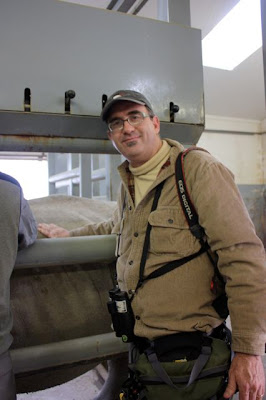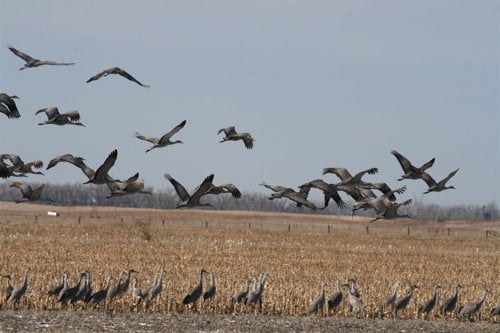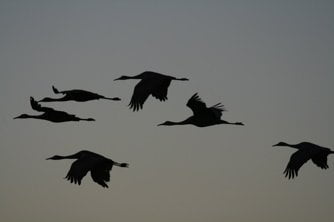Dawn on our road. The kids and I are headed out to The Wilds!
Each January, we take part in the Ohio Ornithological Society's field trip to
The Wilds, a 14 square mile reclaimed strip mine that is now billed as the World's Largest Conservation Facility. Sometimes we help guide the groups, and sometimes we just hang out. Usually it's a mix. Everybody helps everybody else find things. That's what makes it fun.
Birders' cars gathered in the parking lot on International Road, January 2011.
photo by Phoebe Linnea Thompson
We hope it won't be freezing cold, but it usually is. There's nothing to stop the wind, and it's always about 20 degrees colder there than it is at home. But there are rough-legged hawks, short-eared owls, eagles, foxes, coyotes, and any number of birds we can't see at home. And there are other birdwatchers, friends of ours, and it's always fun to be out with them.
American bison grazing, The Wilds, January 2011
And there are some rather awesome perks to this trip.
The Wilds' staff has spoiled us terribly. Last year, they let us into the southern white rhino's winter barn, and this year, they raised the bar by letting us into the Asian one-horned rhino barn and the giraffe barn as well as the white rhino barn. Oh, my. If you want to make Science Chimps very, very happy, just let them into animal barns where they can fondle the hoofed stock.
I got a lot of very cool photos last year, because it was a warm and balmy day, nudging into the upper 30's, with lovely sun. I kept meaning to post them, but spring rolled around and I got seduced by the moment. Sometimes I save the best stuff until it's almost spoiled.
We waited, listening to the rhino keeper talk about his charges. My inner Chimp was jumping up and down, hooting. I was about to see a rhino up close!
Bill of the Birds got his pats in.
I discovered very quickly where the southern white rhino's sweet spot is. It's the incredibly soft, warm fold between his massive abdomen and his hind leg. Why, that's Chet Baker's sweet spot, too. I was using dog knowhow on rhinos, which turns out to be a good strategy. I commenced to scratching in there and the huge animal leaned toward me, holding his leg out, in rhino nirvana.
Well, it was a commensal relationship because it made me happy, too. At one point the rhino fell almost over, he was leaning so hard and holding that near hind leg up. My hand got kind of gooshed between the rhino and the four-inch steel bar that holds the animals in. I was OK. I'm sure the rhino was very sorry.
Southern white rhinos are very, very sweet animals.
I sorry, Miss Thighscratcher Woman. I know I am fat and heavy and you are small. Is your hand OK?
Southern white rhinos are soulful and serene and their eyes are wise. In personality, from my limited experience, I would place them somewhere between a very nice horse and a dog. They're more into being petted than horses are, which moves them toward doglike.
I so wanted to climb into the pen with them, but even with a raging case of rhino fever I knew that would be a dumb thing to do.
Needless to say, Phoebe and Liam were enchanted by these enormous, puppylike beasts, especially when one sat down on his haunches. What a sight.
Just huge.




















































